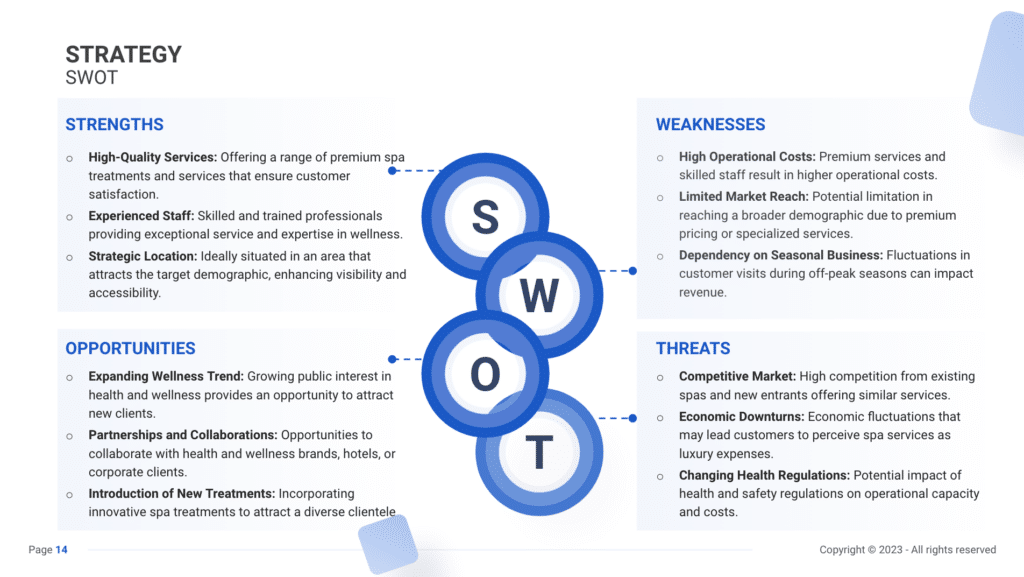How to Prepare a SWOT for a Spa

When crafting a business plan for a massage therapy spa, integrating a SWOT analysis is a crucial element. SWOT, which stands for Strengths, Weaknesses, Opportunities, and Threats, is a structured approach that aids spa owners in examining their business from various perspectives.
Strengths and weaknesses are internal factors, within the spa’s control, while opportunities and threats are external factors that can significantly influence the business.
The objective of a SWOT analysis in a massage therapy spa’s business plan is to provide a detailed snapshot of the spa’s current standing in the market and to highlight potential areas for growth and improvement.
For example, strengths of a massage therapy spa might include a diverse range of services, a team of skilled therapists, or a serene and inviting spa environment. Weaknesses might encompass aspects like limited marketing efforts or a less accessible location.
This article will explore a range of strengths and weaknesses, offering massage therapy spa owners valuable insights on how to effectively incorporate these elements into their business strategies.

Strengths
- Professional Expertise: Trained therapists with diverse skill sets attract a broad clientele seeking specialized treatments.
- Example: Offering unique massage techniques, like hot stone therapy, enhances the business’s appeal.
- Client-Centric Approach: Personalized sessions and tailored treatments foster customer satisfaction and loyalty.
- Example: Implementing a loyalty program for repeat clients reinforces the commitment to customer well-being.
- Prime Location: A strategic and accessible location contributes to increased foot traffic and client convenience.
- Example: Establishing a visible storefront in a busy shopping district maximizes walk-in opportunities.
Weaknesses
- Limited Service Offerings: Offering a narrow range of services may limit attracting a diverse client base.
- Example: Expanding services to include complementary therapies broadens the business’s market appeal.
- Staffing Constraints: A shortage of qualified therapists can result in appointment delays and potential client dissatisfaction.
- Example: Recruiting additional therapists or implementing flexible schedules addresses staffing challenges.
- Technology Gaps: Insufficient integration of technology for bookings and payments may lead to operational inefficiencies.
- Example: Adopting an online booking system streamlines the reservation process and enhances customer experience.
Opportunities
- Wellness Partnerships: Collaborating with fitness centers or healthcare providers can expand the client base.
- Example: Partnering with local gyms for joint promotions introduces massage therapy to a new audience.
- Specialized Events: Hosting wellness workshops or events can attract new clients and foster community engagement.
- Example: Organizing a stress-relief workshop positions the business as a wellness advocate and attracts new clients.
- Digital Marketing: Utilizing social media and online platforms can increase visibility and reach a broader audience.
- Example: Implementing targeted Facebook ads or Instagram campaigns can attract clients interested in specific massage modalities.
Threats
- Competitive Market: Intense competition may impact pricing strategies and require innovative marketing approaches.
- Example: Offering package deals or loyalty discounts helps retain clients in a competitive market.
- Economic Downturns: Economic uncertainties can lead to reduced discretionary spending on wellness services.
- Example: Introducing budget-friendly packages or discounts during economic downturns can mitigate the impact.
- Regulatory Changes: Evolving regulations in the wellness industry may necessitate compliance adjustments.
- Example: Staying informed and proactively adapting to new regulations ensures continued legal adherence.





